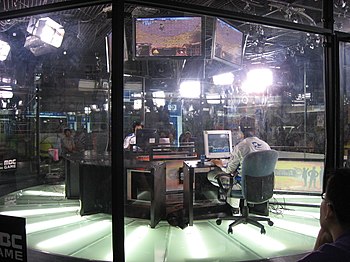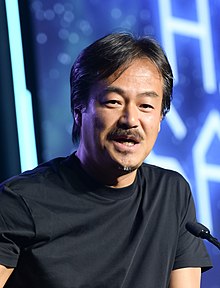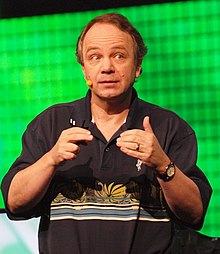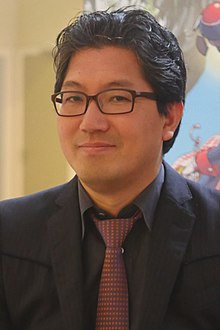Portal:Video games
The Video Games Portal

A video game or computer game is an electronic game that involves interaction with a user interface or input device (such as a joystick, controller, keyboard, or motion sensing device) to generate visual feedback from a display device, most commonly shown in a video format on a television set, computer monitor, flat-panel display or touchscreen on handheld devices, or a virtual reality headset. Most modern video games are audiovisual, with audio complement delivered through speakers or headphones, and sometimes also with other types of sensory feedback (e.g., haptic technology that provides tactile sensations). Some video games also allow microphone and webcam inputs for in-game chatting and livestreaming.
Video games are typically categorized according to their hardware platform, which traditionally includes arcade video games, console games, and computer (PC) games; the latter also encompasses LAN games, online games, and browser games. More recently, the video game industry has expanded onto mobile gaming through mobile devices (such as smartphones and tablet computers), virtual and augmented reality systems, and remote cloud gaming. Video games are also classified into a wide range of genres based on their style of gameplay and target audience. (Full article...)
Featured articles –
In Islanders, players earn points by strategically placing buildings from their inventory onto a procedurally generated island. Earning points restocks the building inventory, eventually unlocking new types of buildings and the ability to move to a new island and continue the session. The session ends when no more points can be gained because no buildings are available or there is no space to place them. The overall goal of the game is to obtain the highest score possible in a single session.
Islanders was developed over seven months while the members of Grizzly Games were completing degrees in video game design at HTW Berlin. The developers were inspired by a mutual love of city-building games, and chose to embrace simplicity in designing Islanders because of the limitations of working with a small team. Employing procedural generation of new islands enabled them to keep the game's mechanics simple while still providing the player enough variety to make the game engaging for repeat sessions. (Full article...)
Resident Evil: Apocalypse is set directly after the events of the first film, where Alice escaped from an underground facility overrun by zombies. She now bands together with other survivors to escape the zombie outbreak which has spread to the nearby Raccoon City. The film borrows elements from several games in the Resident Evil series, such as the characters Valentine and Olivera and the villain Nemesis. Filming took place in Toronto at locations including Toronto City Hall and Prince Edward Viaduct.
Resident Evil: Apocalypse received "generally unfavorable reviews" on Metacritic, and became the lowest-rated film in the Resident Evil series on Rotten Tomatoes, with a rating of 19%. Despite this, it earned $129.3 million worldwide on a $45 million budget, surpassing the box office gross of the original film. It was followed by Resident Evil: Extinction in 2007. (Full article...)

Sonic the Hedgehog is a video game series and media franchise created by the Japanese developers Yuji Naka, Naoto Ohshima, and Hirokazu Yasuhara for Sega. The franchise follows Sonic, an anthropomorphic blue hedgehog who battles the evil Doctor Eggman, a mad scientist. The main Sonic the Hedgehog games are platformers mostly developed by Sonic Team; other games, developed by various studios, include spin-offs in the racing, fighting, party and sports genres. The franchise also incorporates printed media, animations, feature films, and merchandise.
Naka, Ohshima, and Yasuhara developed the first Sonic game, released in 1991 for the Sega Genesis, to provide Sega with a mascot to compete with Nintendo's Mario. Its success helped Sega become one of the leading video game companies during the fourth generation of video game consoles in the early 1990s. Sega Technical Institute developed the next three Sonic games, plus the spin-off Sonic Spinball (1993). A number of Sonic games were also developed for Sega's 8-bit consoles, the Master System and Game Gear. After a hiatus during the unsuccessful Saturn era, the first major 3D Sonic game, Sonic Adventure, was released in 1998 for the Dreamcast. Sega exited the console market and shifted to third-party development in 2001, continuing the series on Nintendo, Xbox, and PlayStation systems. Takashi Iizuka has been the series' producer since 2010.
While Sonic games often have unique game mechanics and stories, they feature recurring elements such as the ring-based health system, level locales, and fast-paced gameplay. Games typically feature Sonic setting out to stop Eggman's schemes for world domination, and the player navigates levels that include springs, slopes, bottomless pits, and vertical loops. Later games added a large cast of characters; some, such as Miles "Tails" Prower, Knuckles the Echidna, and Shadow the Hedgehog, have starred in spin-offs. The franchise has crossed over with other video game franchises in games such as Mario & Sonic, Sega All-Stars, and Super Smash Bros. (Full article...)
Nintendo Entertainment Analysis & Development developed the game, led by director Takashi Tezuka and producer and series creator Shigeru Miyamoto. It is the first Mario game for the SNES and was designed to make the most of the console's technical features. The development team had more freedom compared to the series installments for the Nintendo Entertainment System (NES). Yoshi was conceptualised during the development of the NES games but was not used until Super Mario World due to hardware limitations.
Super Mario World is often considered one of the best games in the series and is cited as one of the greatest video games ever made. It sold more than twenty million copies worldwide, making it the best-selling SNES game. It also led to an animated television series of the same name and a 1995 sequel, Yoshi's Island. The game has been re-released on multiple occasions: It was part of the 1994 compilation Super Mario All-Stars + Super Mario World for the SNES and was re-released for the Game Boy Advance as Super Mario World: Super Mario Advance 2 in 2001, on the Virtual Console for the Wii, Wii U, and New Nintendo 3DS consoles, and as part of the Super NES Classic Edition. In 2019, it was released for Nintendo Switch Online as part of the classic games service. (Full article...)

Gravity Bone is a 2008 freeware adventure game developed and published by Blendo Games. The game employs a modified version of id Software's id Tech 2 engine—originally used for Quake 2—and incorporates music from films by director Wong Kar-wai, which were originally performed by Xavier Cugat. Four incarnations of the game were produced during its one-year development; the first featured more common first-person shooter elements than the released version. Subsequent versions shifted in a new direction, with the inclusion of more spy-oriented gameplay. The game was released for Microsoft Windows in August 2008.
Gravity Bone received critical acclaim from video game journalists. It was called "a pleasure to experience" by Charles Onyett from IGN, and received comparisons to games such as Team Fortress 2 and Portal. The game was praised for its cohesive story, atmosphere and its ability to catch the player's interest over a very short time span without feeling rushed or incomplete. It received the "Best Arthouse Game" award in Game Tunnel's Special Awards of 2008. A sequel, Thirty Flights of Loving, was released in 2012. (Full article...)
After the success of Halo: Combat Evolved, a sequel was expected and highly anticipated. Bungie found inspiration in plot points and gameplay elements that had been left out of their first game, including online multiplayer. A troubled development and time constraints forced cuts to the scope of the game, including the wholesale removal of a more ambitious multiplayer mode, and necessitated a cliffhanger ending to the game's campaign mode. Among Halo 2's marketing was an early alternate reality game called "I Love Bees" that involved players solving real-world puzzles. Bungie supported the game after release with new multiplayer maps and updates to address cheating and glitches. The game was followed by a sequel, Halo 3, in September 2007.
Halo 2 was a commercial and critical success and is often listed as one of the greatest video games of all time. The game became the most popular title on Xbox Live, holding that rank until the release of Gears of War for the Xbox 360 nearly two years later. Halo 2 is the best-selling first-generation Xbox game, with more than 8 million copies sold worldwide. The game received critical acclaim, with the multiplayer lauded; in comparison, the campaign and its cliffhanger ending was divisive. The game's online component was highly influential and cemented many features as standard in future games and online services, including matchmaking, lobbies, and clans. Halo 2's marketing heralded the beginnings of video games as blockbuster media. A port of the game for Windows Vista was released in 2007, followed by a high-definition remake as part of Halo: The Master Chief Collection in 2014. (Full article...)
Aria of Sorrow is set in the year 2035, when Dracula has been sealed away after a battle in 1999. The plot follows the journey of Soma Cruz, a teenager granted occult power as a result of being a potential vessel of Dracula's reincarnation, as he battles dark figures that wish to inherit the undead lord's power. The game has been described as an action-adventure game with elements of role-playing games. Aria of Sorrow introduces several features to the series, such as the "Tactical Soul" system and employs a futuristic storyline in contrast to the medieval setting of other Castlevania games.
Aria of Sorrow was released in May 2003. Although it sold poorly in Japan, selling 27,000 units nearly one month after its release, it was commercially successful in the United States, with more than 158,000 units sold in the three months following its release. Aria of Sorrow received universal acclaim, with praise for its visuals, gameplay (particularly the Tactical Soul System), music, and level design. Some critics considered it the best Castlevania game since Symphony of the Night. (Full article...)
Did you know... -
- ... that the video game Omori came out in December 2020, instead of its initial projected release date of May 2015?
- ... that the 2015 video game Worlds of Magic, intended as a spiritual successor to the classic game Master of Magic, failed to impress most reviewers?
- ... that deceased YouTuber Technoblade beat the video game Minecraft in hardcore mode using a racing-wheel controller?
- ... that the European version of the video game Tomba! uses the theme song of the television series No Sweat as its opening theme?
- ... that Splatoon 3 became the fastest-selling video game of all time in Japan three days after launch?
- ... that classified documents of the United States were partially leaked onto a Discord server for the video game Minecraft?
- ... that the graffiti artists hired for the video game Skitchin' were interviewed at a train station because they were too young to drive?
- ... that the video game Manor Lords was wishlisted more than three million times on Steam after its developer had estimated it would receive around 14,000?
- ... that Terra Invicta's development company is a group of former volunteer video game modders that decided to release their own game after the success of their mod?
- ... that when Kaz Ayabe pitched his video game Boku no Natsuyasumi to Sony, he said that illustrator Mineko Ueda was interested in the project even though they had never actually met?
- ... that the concept of adding strippers to the extreme sports video game BMX XXX was initially proposed in jest?
- ... that the case Lewis Galoob Toys, Inc. v. Nintendo of America, Inc. was considered essential to the future of video game modding in the United States in 1992?
Selected biography –
Selected image -

- April 16, 2024 – 2023–2024 video game industry layoffs
- American video game company Take-Two Interactive lays off 5% of its workforce. (Reuters)
- April 10, 2024 – 2023–2024 video game industry layoffs
- American video game company Epic Games announces that it will lay-off around 870 employees, roughly one-sixth of its workforce, due to slower growth than expected. (CBC via Yahoo! News)
- December 22, 2023 –
- China passes a series of regulations aimed at limiting video game microtransactions. The new rules include banning rewards for logging on for multiple consecutive days and banning rewards for players if they spend money in a game for the first time. (Reuters)
Topics
Categories
Things you can do
In other Wikimedia projects
The following Wikimedia Foundation sister projects provide more on this subject:
-
Commons
Free media repository -
Wikibooks
Free textbooks and manuals -
Wikidata
Free knowledge base -
Wikinews
Free-content news -
Wikiquote
Collection of quotations -
Wikisource
Free-content library -
Wikiversity
Free learning tools -
Wiktionary
Dictionary and thesaurus

![Image 1 MissingNo. (Japanese: けつばん[] Error: {{Lang}}: no text (help), Hepburn: Ketsuban) is a glitch and an unofficial Pokémon species found in the video games Pokémon Red and Blue. Due to the programming of certain in-game events, players can encounter MissingNo. via a glitch. It is one of the most famous video game glitches of all time. Encountering MissingNo. causes graphical anomalies and changes gameplay by increasing the number of items in the sixth entry of the player's inventory by 128. This beneficial effect resulted in the glitch's coverage by strategy guides and game magazines, while game publisher Nintendo warned that encountering the glitch may corrupt players' game data. IGN noted MissingNo.'s appearance in Pokémon Red and Blue was one of the most famous video game glitches and commented on its role in increasing the series' popularity. Fans have attempted to rationalize and incorporate MissingNo. as part of the games' canon as an actual in-game character, and sociologists have studied its impact on both players and gaming culture as a whole. Additionally, references to the glitch and the circumstances around it have also appeared in other games, such as Vampire Survivors and The Binding of Isaac. (Full article...)](http://upload.wikimedia.org/wikipedia/en/d/d2/Blank.png)












































